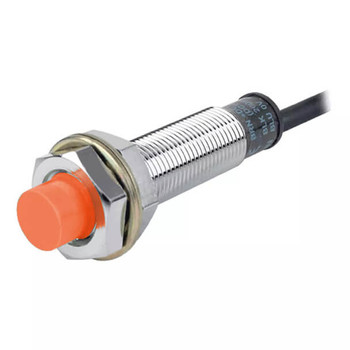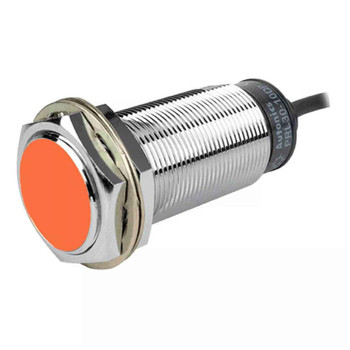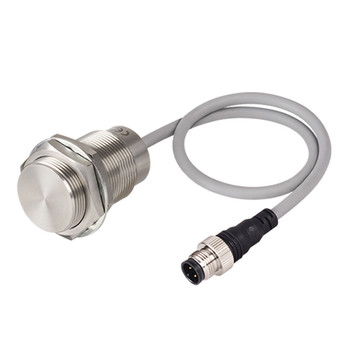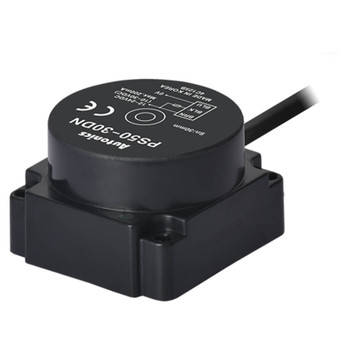Proximity Sensor
Proximity Sensors; Detect objects, contactless
Proximity sensors, also known as proximity detectors or proximate sensors, are electronic marvels that detect the presence or absence of metallic objects without physical contact. These versatile sensors are crucial components in various applications, from industrial automation to consumer electronics.
-

Inductive Sensor M12, PNP NO - PRL12-4DP
Autonics
Discover the PRL12-4DP Inductive Sensor for Seamless Industrial Automation Unlock Precision and Efficiency Experience enhanced performance and seamless sensing with the Autonics PRL12-4DP inductive sensor. Designed to deliver superior... -

Inductive Sensor M30, PNP NO, Flush - PRL30-10DP
Autonics
Revolutionize Your Sensing Capabilities with the PRL30-10DP Inductive Sensor Enhanced Accuracy and Efficiency Await! Experience the next level of sensing technology with the Autonics PRL30-10DP inductive sensor. This state-of-the-art... -

Inductive Sensor M18, PNP NO, Flush - PRCML18-5DP
Autonics
Autonics M18, PNP NO proximity sensor - PRCML18-5DP Shield (flush), Standard connector, 5 mm Sensing distance The Autonics sensor PRCML18-5DP features outstanding noise protection and stable sensing performance due to its specialized sensor... -

Inductive Sensor M18, PNP NO - PRL18-8DP
Autonics
Enhance Your Automation with the PRL18-8DP Inductive Sensor Superior Performance and Unmatched Customer Support Experience unparalleled sensing performance with the Autonics PRL18-8DP inductive sensor. Engineered to deliver precise and reliable... -

Inductive Sensor M18, PNP NO, Flush - PRL18-5DP
Autonics
Introducing the Autonics PRL18-5DP Inductive Sensor Enhanced Precision and Seamless Integration The Autonics PRL18-5DP inductive sensor is a state-of-the-art device designed to revolutionize your sensing applications. With its remarkable... -

Inductive Sensor M18, NPN NO, Flush - PRL18-5DN
Autonics
Enhance Your Sensing Solutions with the Autonics PRL18-5DN Inductive Sensor Precision, Durability, and Unmatched Customer Service The Autonics PRL18-5DN Inductive Sensor revolutionizes your sensing capabilities with its advanced features and... -

Inductive Sensor M18, PNP NO - PR18-8DP
Autonics
Autonics inductive proximity sensor M18, PNP NO - PR18-8DP Non Shield (non-flush), Cable type connection, 8 mm Sensing distance The Autonics proximity sensor PR18-8DP features outstanding noise protection and stable sensing performance due to its... -

Weld Immune Proximity Sensor M18, PNP NO, Flush - DW-AS-623-M18-120
Contrinex
Contrinex proximity sensor M18, PNP NO - DW-AS-623-M18-120 Embeddable (flush), M12 4-pin, 8 mm Sensing distance The Contrinex proximity sensor DW-AS-623-M5 features outstanding noise protection and stable sensing performance due to its specialized... -

Rectangular Proximity Sensor 17 mm, NPN NO - PSN17-5DN
Autonics
Autonics proximity sensor 17mm, NPN NO - PSN17-5DN Rectangular, Cable type connection, 5 mm Sensing distance The Autonics proximity sensor PSN17-5DN features outstanding noise protection and stable sensing performance due to its specialized... -

Inductive Sensor M12, NPN NO - PR12-4DN
Autonics
Autonics cylindrical inductive proximity sensor PR12-4DN Non-shield (non-flush), Cable type, 4 mm Sensing distance The Autonics proximity sensor PR12-4DN features solid sensing performance and excellent noise immunity with a specialized... -

Analog Proximity Sensor M18, 4 wire, Semi-flush - IS 518-02A
Sensopart
SensoPart Inductive sensor with analog output - IS 518-02A Quasi-flush, 4-wire, M18 x 50 mm Dimensions The SensoPart analog proximity sensor IS 518-02A features short-circuit protection (Q) and overload protection protective... -

Proximity Sensor M30, NPN NO - DW-AD-701-M30
Contrinex
Contrinex inductive proximity sensor M30, NPN Normally open NO DW-AD-701-M30 Standard output, 3-wire type, Embeddable, 20 mm sensing distance Body The DW-AD-701-M30 has housing size of M30 and the mounting type is embeddable. This proximity sensor... -

Full Metal Proximity Sensor M30, DC 2 wire, Normally Open, Flush - PRFWT30-10DO-IV
Autonics
This particular product is made up of sensing side diameter of M30 along with minimum sensing distance of about 10 mm. This product meets all of your requirements and also possess adequate VDC. With being made on a very secured... -

Full Metal Proximity Sensor M12, DC 2 wire, Normally Open, Flush - PRFT12-2DO-V
Autonics
Autonics proximity sensor M12, NO PRFT12-2DO-V Shield (flush), Cable type connection, 2 mm Sensing distance The Autonics PRF series proximity sensor PRFT12-2DO-V features outstanding noise protection and stable sensing performance due to its... -

Rectangular Proximity Sensor 50 mm, PNP NO - PS50-30DP
Autonics
Autonics proximity sensor 50mm, PNP NO - PS50-30DP Rectangular, Cable type connection, 30 mm Sensing distance The Autonics proximity sensor PS50-30DP features outstanding noise protection and stable sensing performance due to its specialized... -

Rectangular Proximity Sensor 40 mm, PNP NO - PSN40-20DP
Autonics
Autonics proximity sensor 40mm, PNP NO PSN40-20DP Rectangular, Cable type connection, 20 mm Sensing distance The Autonics proximity sensor PSN40-20DP features outstanding noise protection and stable sensing performance due to its specialized... -

Rectangular Proximity Sensor 30 mm, PNP NO - PSN30-15DP
Autonics
Autonics proximity sensor 30mm, PNP NO PSN30-15DP Rectangular, Cable type connection, 15 mm Sensing distance The Autonics proximity sensor PSN30-15DP features outstanding noise protection and stable sensing performance due to its specialized... -

Rectangular Proximity Sensor 30 mm, NPN NC - PSN30-15DN2
Autonics
Autonics proximity sensor 30mm, NPN NC PSN30-15DN2 Rectangular, Cable type connection, 15 mm Sensing distance The Autonics proximity sensor PSN30-15DN2 features outstanding noise protection and stable sensing performance due to its specialized... -

Rectangular Proximity Sensor 30 mm, PNP NO - PSN30-10DP
Autonics
Autonics proximity sensor 30mm, PNP NO PSN30-10DP Rectangular, Cable type connection, 10 mm Sensing distance The Autonics proximity sensor PSN30-10DP features outstanding noise protection and stable sensing performance due to its specialized... -

Rectangular Proximity Sensor 17 mm, PNP NC - PSN17-8DP2
Autonics
Autonics proximity sensor 17mm, PNP NC PSN17-8DP2 Rectangular, Cable type connection, 8 mm Sensing distance The Autonics PS Series proximity sensor PSN17-8DP2 features outstanding noise protection and stable sensing performance due to its...
